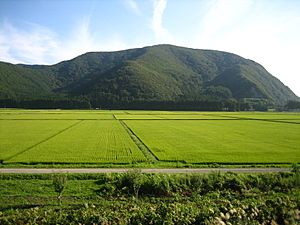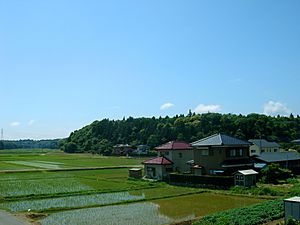Rice production in Japan facts for kids
Rice is a super important food in Japan, and it's a big part of what Japanese people eat every day. It's like bread or potatoes in other countries – a main food!
Contents
Growing Rice in Japan
Japan is one of the top countries in the world for growing rice. It's actually the ninth largest producer! This is really important for making sure Japan has enough food for everyone.
When Rice Grows
The time when rice grows depends on where you are in Japan:
- In Northern Japan, rice grows from May or June until September or October.
- In Central Japan, it's from April or May until August or October.
- In Southern Japan, the season is from April or May until August or September.
About 85% of the 2.3 million farms in Japan grow rice every year. Most of them grow a special kind of rice called japonica rice. The most popular type of japonica rice is called Koshihikari.
How Rice Farms Work
Japanese rice farms are usually quite small. Even though they are small, farmers use a lot of machines to help them grow rice. This is called mechanized agriculture. Because the farms are small, many farmers do rice farming as a part-time job.
Over the years, fewer people have been farming in Japan, and less rice is being grown. This started because the government asked farmers to grow less rice back in 1969. The government has a lot of control over how rice is grown and sold in Japan.
Farmland in Japan
Japan doesn't have a lot of flat land for farming. Most of the land is covered by mountains. So, farmers use the land they have very carefully. Rice fields, called Paddy fields, are found everywhere – on flat plains, on hillsides that are shaped like steps (terraces), and even in wet, swampy areas or near the coast.
Farmers also grow other crops like wheat, barley, sweet potatoes, and vegetables. Sometimes, they plant different crops in the same field at different times of the year. For example, they might grow beans and peas along with other crops. The Japanese government sometimes pays farmers to grow other crops instead of rice to help balance the market.
History of Rice in Japan
Rice has been grown in Japan for a very long time. Some studies show that a type of rice that grows in dry fields might have been in Japan as early as 6,000 years ago, during the Early Jōmon period. Growing rice in wet fields (paddy fields) started later, between the end of the Jōmon period and the start of the Yayoi period. This was a big change for Japan, as it was the first time people grew crops in a very organized way. Rice has a special and important place in Japanese history, culture, and how the country works.
Small Farms and Rice Rules
After World War II (between 1945 and 1949), the government changed land rules. Farms in Japan stayed small and spread out. To keep farms from becoming too big, regular companies cannot own farmland. Only farming groups can own land if they actually farm it.
Today, the average Japanese rice farmer works on a very small area, about 1.65 acres. That's a little bigger than a football field. To give you an idea, a typical farm in America is about 160 times bigger!
The Japanese government has strict rules about rice. For example, they usually don't allow rice from other countries to be imported, unless it's already processed into something else. Also, farmers have a strong voice in the government, so the government helps them by giving them money, which is called a subsidy. This means rice prices in Japan can be higher than in other countries.
Japan says it bans rice imports to make sure it can grow enough food for its own people, which is called self-sufficiency. Also, many people in Japan believe that growing rice is a big part of Japanese culture. However, it's becoming harder to get younger people interested in farming, even with government help.
Even though rice prices are high, most Japanese people don't mind too much. This is because they spend less of their total money on food as their incomes have grown. Many Japanese people also believe that rice grown in Japan tastes better than foreign rice.
Trade Talks About Rice
In the 1990s, during big international trade talks called the Uruguay Round of GATT (General Agreement on Tariffs and Trade), Japan refused to allow more rice imports. Some people thought that if Japan allowed imports, the United States could sell a lot of rice there.
More recently, around 2010, there were new talks about free trade as part of something called the Trans-Pacific Partnership. Rice imports were discussed again in Japan during these talks.
What Japan Grows
Besides rice, Japan grows many other crops. Here are some of the amounts grown in 2016:
- Rice: 11 million metric tons
- Sugar beets: 4.7 million metric tons
- Potatoes: 2.9 million metric tons
- Cabbage: 2.3 million metric tons
- Mandarin oranges: 1.4 million metric tons
- Onions: 1.1 million metric tons
- Sweet potatoes: 1 million metric tons
- Apples: 881,100 metric tons
- Cucumbers: 700,000 metric tons
Other crops include melons, tomatoes, wheat, soybeans, tea, and various other fruits and vegetables.



